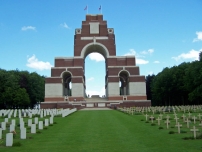| First Name: | Henry Arthur Percival | Last Name: | RICHARDSON | |
|---|---|---|---|---|
| Date of Death: | 15/09/1916 | Lived/Born In: | Blackheath | |
| Rank: | Private | Unit: | Royal Fusiliers32 | |
| Memorial Site: | Thiepval Memorial, France | |||
Current Information:Age-33 134, Regents Park Road, Chalk Farm
The Battle of the Somme (July-November, 1916) By the beginning of September, 1916, the Battle of the Somme had been raging for two months. Thousands of men had already been killed or wounded or were simply missing, never to be seen again and and just a few square miles of the French countryside, all in the southern part of the battlefield, had been captured from the enemy. Mistakes had been made by the various commanders and would be continued to be made but there was no turning back as the British, Australians, South Africans, New Zealanders and Canadians carried on battering away at the German defences in the hope of a breakthrough, So it continued all the way through to November with nearly every battalion and division then in France being drawn into it at some stage. In the end the German trenches had been pushed back a few more miles along most of the line but the cost in lives had been staggering. By the end of the fighting in November, 1916, British Army casualties numbered over 400,000, killed, wounded and missing. On 15th September, 1916, the offensive on the Somme was renewed with a full scale attack on the German 3rd line of defences. Four Army Corps were used on a front that stretched from Combles, through the village of Flers and on to Courcelette. The artillery barrage that preceded this attack was more concentrated than that on 1st July and the attack itself was more successful. The villages of Flers, Martinpuich and Courcelette were captured and the enemy was finally pushed out of High Wood, but the breakthrough was not achieved and the reality was that when the battle ended on 22nd September, the front line had just been moved forward a mile or so. The battle is notable for being the first time that tanks were used. 41st Division attacked the village of Flers on 15th September. They had ten tanks attached for this operation, seven of which made it to the starting line. Their assault on the enemy positions was made by 122 Brigade and 124 Brigade at 6.20am with the troops advancing behind a creeping barrage laid down by their own artillery. 124 Brigade attacked on the right of the divisional front with 10th Royal West Surrey (Queens) and 21st King’s Royal Rifle Corps leading and 26th Royal Fusiliers and 32nd Royal Fusiliers in support. Some of the over eager front waves got too close the creeping barrage and suffered casualties. There was little resistance at first and the badly battered Tea Support Trench soon fell to them. By 7am the first objective, the Switch Line, had been taken and twenty minutes later the two Royal Fusilier battalions advanced on Flers Trench, on the other side of the village, which they captured after some heavy fighting, Thirty minutes later parties of men set off for the third objective but by now resistance was stiffening and only a few footholds were made into this. This overall success in Capturing Flers however, did not come without a cost in human life and suffering. The casualty list was a long one and included Henry Richardson of 32nd Royal Fusiliers. |
||||
| « Back to Search Results | ||||
| If you think any of the information shown here is incorrect, Click Here to submit your amends and comments | ||||




